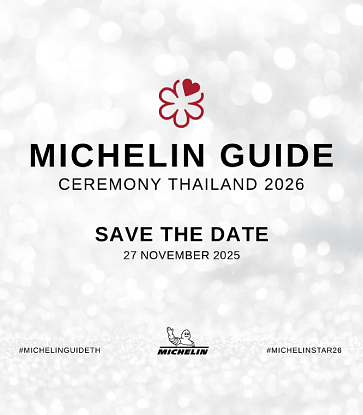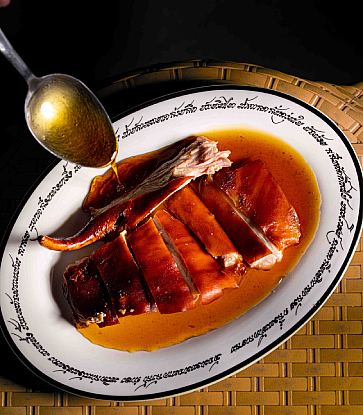When asked about Eastern Thailand’s highlights, most people probably could not talk about it as easily as the big four regions of Central, Northern, Southern, and Northeastern Thailand. This doesn’t mean Eastern Thailand lacks in natural marvels. There are beautiful mountains and seas, as well as fascinating cultures, and of course, distinctive cuisine. Let’s explore how Eastern food is different from other parts of Thailand, and what are some dishes you won’t want to miss.
MICHELIN Guide invites an expert to provide his insights. Trat-born Wongwich “Ack” Sripinyo has been passionate about telling stories of Eastern Thailand via food. His restaurants – Sri Trat and Burapa – have Bib Gourmand status in the 2023 MICHELIN Guide Thailand. Today, Chef Sripinyo will be our guide to exploring Eastern cuisine.
“There are actually eight provinces in Eastern Thailand. However, when people talk about ‘Eastern food’, they usually mean only three, Rayong, Chanthaburi, and Trat. These provinces share geographical similarities. They face the sea with mountains at their backs. Eastern food tells stories of local people who cleverly conjure delicious dishes from their precious surroundings, seafood and wild ingredients. The fruits, found all over the region, are another wonder.”

“Eastern food is a balance between its Central and Southern counterparts. It is not as mellow as Central food, which gets its influence from royal cuisine. But it is also not as intense as Southern delicacies. And because we are coastal like the South, we commonly use fleur de sel in our food. The difference is there are more wild ingredients and fruit. Easterners harvest herbs from the mountains and use them for cooking. Unrefined sugar is preferred. So, the final dishes are balanced, yet uniquely flavoursome’.”

Seven Eastern dishes recommended by Chef Sripinyo
Kaeng Mu Chamuang (Stewed Pork Belly Curry with Chamuang Leaves)
This dish embodies local Eastern Thai wisdom. Chamuang (also called garcinia cowa or cowa fruit) thrives all around the region, so locals have discovered the plant’s tartness. With Kaeng Mu Chamuang, the leaves, and sometimes the fruit, are used to balance this curry’s sweetness and spiciness. It is usually a sweeter dish, but individual recipes can vary. The sour Chamuang leaves add depth as well as nutrients, such as beta-carotene, vitamin B1, calcium, iron, and phosphorus. Combined with the pork, your body can be fully nourished.

Khao Klug Prik Kluer (Spicy Seafood Sauce Fried Rice)
Thais are accustomed to eating seafood with dipping sauce, usually a simple mixture of chilli, fish sauce, lime juice, and some garlic. But where did this come from? The sauce was. It started with fishermen. Because they couldn’t light a fire on their boats, the fishermen would cure their fresh catches in vinegar and mix the meat with that delicious sauce (similar to making ceviche). This simple yet innovative dish genuinely showcases local Eastern Thai wisdom.

Tom Nor Krawan (Cardamom Shoot Soup)
This soup focuses on white meat, such as chicken or fish. King Rama V’s travelogue mentioned cardamom shoot as a long-stemmed herb. This plant is aromatic and adds a uniquely sharp taste. Khai tom nor krawan (Cardamom Shoot Soup with Chicken) was originally made from meaty domestic fowl, boiled with chilli, lemongrass, shallot, lime juice, and other ingredients. The result is a clear soup with just a touch of fattiness from chicken or fish skin. The chilli is just lightly pounded to release the aroma. This also helps limit the spiciness. The star of the dish is the cardamom shoot’s piquancy. Together, you have a dish that balances sour, salty, and spicy flavours. Delicious and nutritious.

Kaeng Luk Kluay (Curry with Young Bananas)
Kaeng luk kluay is also a Southern delicacy, but cooks in the East use wild game, including pheasant, duck, pigeon, boar, or beef. Chef Sripinyo features this curry at Sri Trat to preserve its legacy. He used this curry as inspiration for another dish at Burapa. The result is ‘Khao Mun Gaeng Prik Nuer Si Krong Wua (Coconut Rice with Red Rib Curry)’. If you visit Eastern Thailand, don’t forget to look for local places that serve the rare Kaeng Luk Kluay.

Tom Guer (White Coconut Curry)
Thai curries come in five colours; red, yellow, and green most know about. And then there’s black and white. Tom guer gets its whiteness from fresh coconut milk. Crab, bamboo shoots, and the East’s famous shrimp paste add touches from the sea and the wild. The curry is mildly seasoned for a subtle spiciness. Chef Sripinyo offers authentic tom guer at Sri Trat. But at Burapa, it is transformed into Crab Coconut Curry served with homemade noodles. Tom guer is another rare dish we don’t want you to miss when you travel to the East.

Pink Jelly Fish with Peanut Sauce
Another dish that epitomises Eastern Thailand. When fishermen catch jellyfish, especially white jellyfish, they preserve it by fermenting it in water filled with mangrove bark. The meat turns pink and crispy, and they dip the colourful pieces in peanut sauce for an ultimate delight. Burapa has reimagined this local delicacy. The pink jellyfish is fermented further with honey and calamansi juice, adding extra flavours. Then, it’s served with peanut sauce with chilli and salt and topped with Thai mustard green salad. This is another dish to boost your appetite even further.

Chicken Massaman Curry with Durian
Eastern Thailand is the largest fruit producer, including the world-famous durian. Locals get creative by incorporating the king of fruits into savoury dishes. Kaeng Massaman Kai Durian (Chicken Massaman Curry with Durian) reflects this Eastern taste innovation. You can find this unique combination of rich flavours from the spices and sweetness from the durian at many local eateries around Trat and Chanthaburi.

What to do & see in Eastern Thailand?
Although often overlooked, Eastern Thailand is as beautiful and bountiful as the kingdom’s other, more well-known regions. The food that Chef Ack introduced earlier perfectly reflects the Eastern way of life. Eastern food is straightforward, simple, and intimate. The accessible flavours tell stories of the East whilst pleasing the palate.
You may know of Koh Chang and Koh Kood. But there are many other places brimming with natural and culinary wonders waiting to be explored and experienced. The young chef suggests some such hidden gems as the breath-taking, 13-tiered Krathing Waterfall in Chanthaburi’s Khao Khitchakut National Park. Feel nostalgic at the well-preserved Chanthaboon Waterfront Community, where you can enjoy shopping at both mom-and-pop as well as modern stores.
Heading further east to Trat, the Bang Taboon mangrove forest is an eco-community spanning over 2,000 rai (about 3.2 square kilometres). After cruising through the mangroves, refresh yourself with some healthy Baboon’s Head Flower tea at the Ban Tha Ranae Community. Relive the peaceful past at the Khlong Bang Phra Community and Pier whilst enjoying the authentic Eastern food. You will regret never visiting this wondrous region.

Although COVID-19 has been declared endemic, you should still be careful. Wear a mask, rinse your hands, and look for SHA certificates (Amazing Thailand Safety & Health Administration). The SHA project is a result of cooperation between the Ministry of Tourism and Sports, the Tourism Authority of Thailand (TAT), the Ministry of Public Health, the Department of Disease Control, the Department of Health, and the Department of Health Service Support. It guarantees a tourism entrepreneur’s compliance with sanitation measures. The certificate reassures every traveller’s health and safety.
Explore more about SHA at thailandsha.tourismthailand.org. We can also be your travelling companion who provides updates on destinations. Contact TAT Call Center 1672 or Facebook TAT Contact Center.
Illustration image: © Sri Trat






















